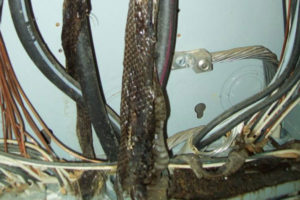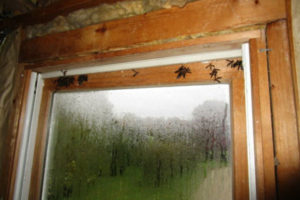We haven’t yet cornered a ghost or a vampire, but we do witness all kinds of crazy bats and critters when we’re inspecting. In the spirit of Halloween, we decided to share just a few real-world photos from actual inspections over the last couple of years.
This Really Is A Bat In Your Belfry

No one wants a bat in the attic.
Bats are health concerns, primarily because of their excrement. Bats are associated with rabies and histoplasmosis, which can be extremely dangerous to humans and household pets.
Hire a specialist to clear the nesting and make any required repairs.
This Snake is Not an Indoor Pet

Even Indiana Jones was afraid of snakes.
It was quite a surprise when we opened an electrical panel and found the skin of a snake.
What’s worse is wondering where that reptile is now lurking!
Snakes like to slither into the best hiding spots they can find, such as attics, crawlspaces, and garages – or in this case, an electrical panel.
Who’s That Masked Bandit?

Four-legged animals with fangs take fear to a whole different level.
No, that’s not a ghost. This “friendly” raccoon was hanging out in the fireplace flue above the damper.
Problem – their were little kids in this house.
Our inspector saved the day by closing and locking the glass doors shut until Mr. Raccoon went away.
Frightfully, Unbelievably High Radon Result

You probably know that radon gas is the second leading cause of lung cancer in the USA (after smoking, of course).
You may even know that the EPA action threshold is 4 pCi/L (picocuries).
A few years back we inspected a house in Pennsylvania that measured an insane 183.2 pCi/L, by far the highest level we’ve ever tested.
We tested for radon again, just to confirm the result. With a reading that high, it was hard to believe.
The owners retained a contractor to fix the radon issue.
Bees, Not What We Wanted To See

Bees are outdoor insects and generally speaking, we do not like to find bees inside a house.
Bees like drywall. Bees like little comfy spaces. Bees like attics.
Most bee infestations occur during the warm months of summer, but bee infestations can occur during the colder months too – just typically with fewer bees.
Bees are a health and safety concern. Hire a specialist to clear the nesting and make required repairs.
